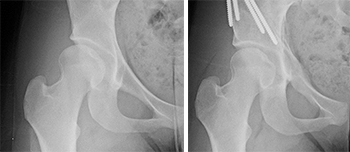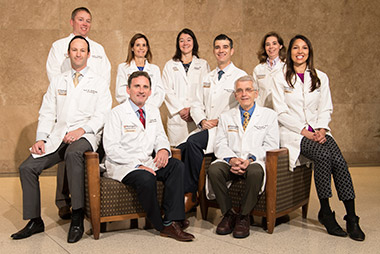March 05, 2018
Hip dysplasia is a common disorder primarily characterized by a “shallow” hip socket (acetabular dysplasia) which can lead to hip symptoms in adolescent and young adult patients. This disorder is associated with activity-related hip pain, functional limitations, reduced quality of life and the eventual development of osteoarthritis. Hip dysplasia most frequently affects young females and is the most common reason for eventual total hip replacement surgery in women. While total hip replacement is a very effective procedure for endstage osteoarthritis in elderly patients, there is a major need for early diagnosis and intervention to prevent or delay the joint problems associated with hip dysplasia in young patients.
Over the past two decades, the hip preservation team at Washington University Orthopedics has been utilizing and refining a procedure known as the Bernese Periacetabular Osteotomy (PAO). The PAO was developed in Switzerland by Reinhold Ganz and colleagues, and is designed to treat the symptoms of hip dysplasia and prevent or delay secondary osteoarthritis and eventual total hip replacement. Over several years, John Clohisy, MD, and Perry Schoenecker, MD, have spearheaded the Washington University initiative to adopt and refine the PAO. This procedure encompasses a series of bone cuts around the hip socket which enables repositioning and correction of the shallow socket deformity. The repositioned socket is then fixed in place with screws to maintain the new position during bone healing. While the early clinical results of the procedure have been encouraging, there is limited information on the results of the procedure over long time periods.
_________________________________________________________________________________________________________________
 Preoperative and postoperative radiographs of the right hip in a twenty year-old female who presented with symptomatic acetabular dysplasia (shallow hip socket). The patient was treated with a PAO to reorient the acetabulum and stabilize the hip. Five years after surgery the patient is asymptomatic and enjoys unrestricted activity.
Preoperative and postoperative radiographs of the right hip in a twenty year-old female who presented with symptomatic acetabular dysplasia (shallow hip socket). The patient was treated with a PAO to reorient the acetabulum and stabilize the hip. Five years after surgery the patient is asymptomatic and enjoys unrestricted activity.
________________________________________________________________________________________________
Recently, our hip preservation team published the clinical outcomes and survivorship of the PAO in the Journal of Bone and Joint Surgery. This study reviewed the Washington University Experience with the PAO procedure in treating symptomatic acetabular dysplasia and documented results at an average 10 years and determined hip survivorship for 15 years after surgery. Our investigators found the PAO procedure preserves the natural hip joint with a survivorship of 92% at fifteen years. In other words, almost all of the patients who underwent PAO had a well-functioning hip and did not need to have a total hip replacement during the fifteen years following surgery. Only 8% of patients underwent a total hip replacement at the 15 year mark. These excellent results support the continued use and refinement of the PAO procedure going forward.
Despite the outstanding results reported, 16% of the patients still had some hip symptoms at the ten-year followup period. Research efforts are currently underway to better define and treat this subgroup of patients to further improve the clinical outcomes of the PAO procedure. In addition to this work regarding the PAO, the Adolescent and Young Adult Hip Center at Washington University encompasses a multidisciplinary group of clinicians and investigators focused on improvement and innovation in the diagnosis and treatment of all pre-arthritic and arthritic hip diseases.
_________________________________________________________________________________________________________________

Adolescent and Young Adult Hip Center Physicians
From left, standing: Jeffrey Nepple, MD,
Cecilia Pascual-Garrido, MD, Ljiljana Bogunovic, MD, Christopher McAndrew, MD, Heidi Prather, DO.
From left, seated: Ryan Nunley, MD, John Clohisy, MD, Perry Schoenecker, MD, Devyani Hunt, MD
_____________________________________________________________________________________________________________________
About Washington University Orthopedics
Whether suffering from a sports injury, hip pain, back pain or any musculoskeletal condition, Washington University Orthopedics provides a full complement of comprehensive orthopedic services to meet the needs of every patient. Combining the best in both inpatient treatment and outpatient care and rehabilitation, the practice is nationally recognized for outstanding orthopedic care, innovative research and advanced professional training. It is ranked among the best orthopedic practices and holds the distinction of being listed on the Honor Roll by U.S. News & World Report. The practice is considered an innovator in both conservative orthopedic care and minimally invasive microsurgical techniques. Affiliated with Barnes-Jewish Hospital and St. Louis Children’s Hospital, Washington University Orthopedics has the unique ability to offer inpatient treatment for the most challenging cases within a top-tier academic medical center as well as outpatient surgery and care across the St. Louis region in Chesterfield, Town and Country, St. Charles, South County and the Central West End. The practice offers expertise in ten orthopedic subspecialties – foot and ankle, hand and wrist, hip and knee, cancer, pediatric and adolescent orthopedics, physical medicine and rehabilitation (physiatry), shoulder and elbow, spine (including scoliosis), sports medicine and fracture care/trauma. The orthopedic specialists are dedicated to providing safe, compassionate and family-centered care for both simple and complex orthopedic conditions. Because of the skill and experience of the doctors and staff, it is the official medical provider for the St. Louis Blues hockey team, Washington University varsity athletics and several local school athletic teams. Washington University Orthopedics brings world-class care to patients from all ages and walks of life in St. Louis and the surrounding communities.